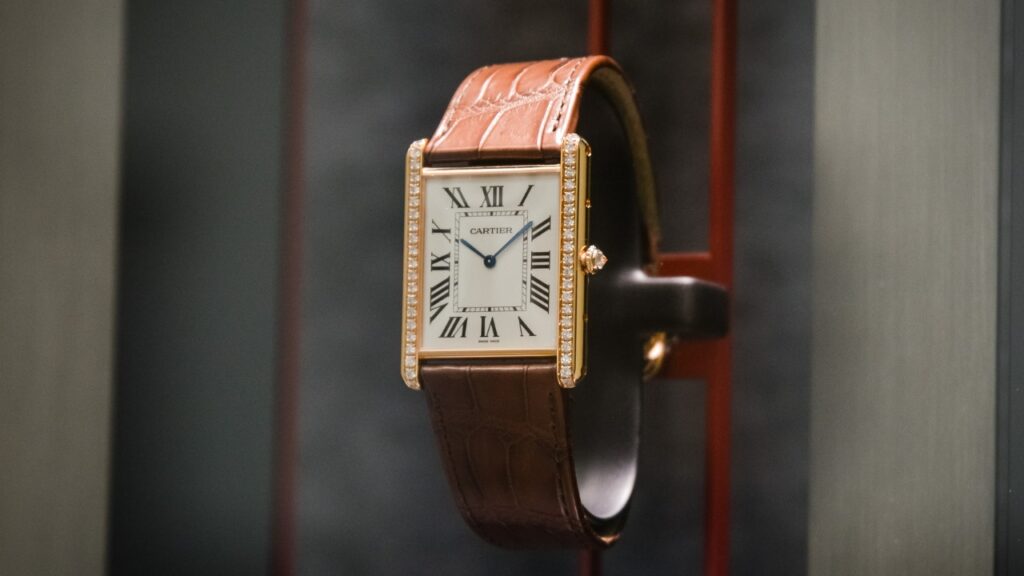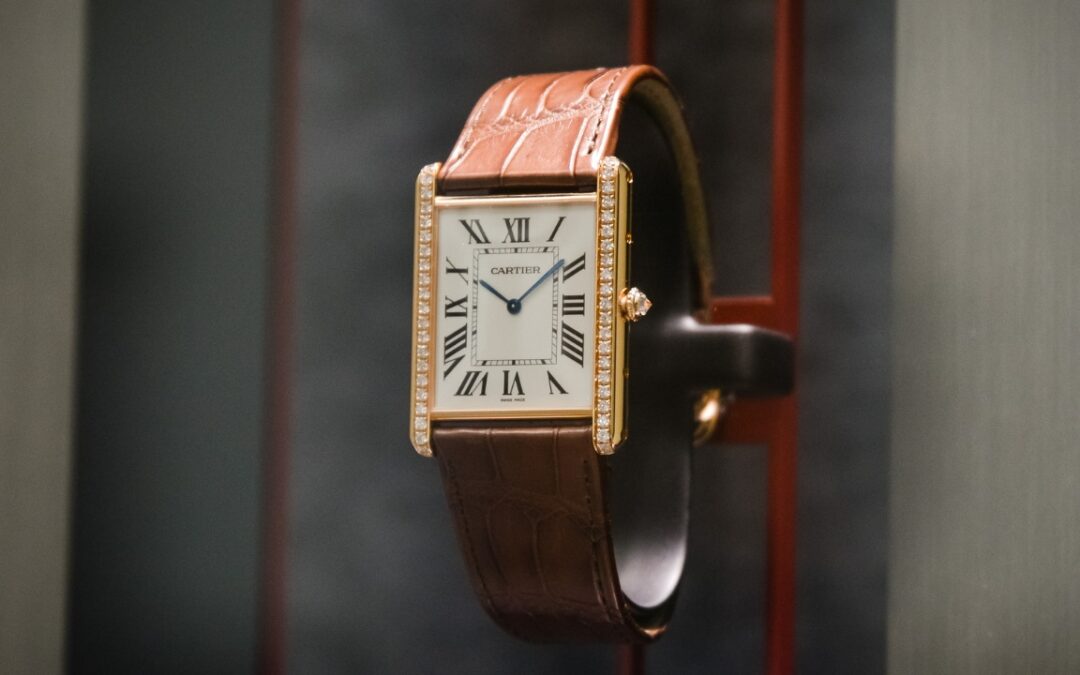Want to know the differences between the Cartier Santos and the Cartier Tank?
Read below and you’ll find out everything you need to know about these iconic timepieces.

At the beginning of the 20th century, soldiers started wearing wristwatches as a more practical on-the-field option over pocket watches. While wrist watches were already gaining popularity among the ladies, they proved their practicality to men in the trenches of WWI.
During World War II, when the military started requiring watches to have round cases, square watches fell out of popularity among men.
Few square-shaped heritage watch models survived Uncle Sam’s demand for rotundity. Round watches are still far more common today. The two most notable exceptions come from Cartier: The Santos and the Tank.
They’re arguably the two most iconic square-shaped watches. If you’re looking to invest in a classic rectangular timekeeper, your research will likely lead you to the Santos and the Tank as two worthwhile finalists.
Santos vs. Tank: Quick Overview
Both the Santos and the Tank have tool watch heritages, but today, are easily categorized as dress watches. This is one of the reasons they’re so distinct.
While they come in a few variations that we’ll get into later, in general, the Cartier Santos is more robust, having more visual cues to its aviator origins. At the same time, the Tank is more clean and simple.
Relatedly, the Santos is generally bigger than the Tank, with medium-sized Santos models often being comparable to XL Tanks.
So the quick-and-dirty is that the Santos is bigger, with a more complex case, while the Tank is classic, uncluttered, and generally “dressier” looking — at least in the traditional sense.
When we zoom into the details, that’s when the differences become more complex.
Cartier Santos
Though the Santos comes in several variants throughout time, it rarely goes too far off template.
The design is known for the extra layer of steel (or precious metal) on top of the bezel, accented with visible screws, giving it a more industrial touch than the minimal bezel of the Tank.
Looks
Focusing on the modern iterations, we’ve got the Santos de Cartier and the Santos Dumont. Most have the Deco-slanted Roman numerals, blue or white hands (blue is arguably more signature than white), and the chemin de fer chapter ring (the railroad middle center track beneath the indices).
The Santos de Cartier is slightly more brawny-looking than the Dumont. In fact, it doesn’t come in a small size, just medium, large, and XL, which is a whopping 43.3mm. This is huge for a dress watch, especially a square-shaped one.
The top metal piece of the bezel is more substantial, going all the way to the vertical edges of the case. This visually integrates the bezel with the steel bracelet, which is also designed with visible screws.
Even the crown is shaped like a screw fastener, further fortifying the slight “industrialness.”
Some Santos de Cartiers have date windows at the six position, offering even more visual variation on the watch face.
Qualities that make the Santos Dumont look dressier than the de Cartier include its (usually) leather strap, its guardless case, and its crown, which has a more regal onion shape, often with a sapphire crystal that sticks out.
Most noticeable is the top metal piece on the bezel, which is a free-form square, unintegrated from the bracelet, and therefore perfectly framed by the case it sits on. This gives it a cleaner look than the de Cartier. The Dumont also comes in a small size, a traditional 38mm by 27.5mm.
Basically, the Santos Dumont is a sort of visual missing link between the Tank and the Santos de Cartier.
When it comes to less classic variants, both have skeleton dial versions. Additionally, the Santos Dumont Reference W2SA0025 features Arabic numerals and sweeping lugs, and the Santos de Cartier comes as a chronograph.
Worth mentioning is the Santos 100 collection from 2004 because it combines qualities of both Santos sublines. It has the cleaner-looking disconnected top bezel, but the screw-fastener crown which is surrounded by crown guards.
Features
Related to looks, modern Santos watches are made out of basically any material a watch can be made out of. You can find them in white gold, rose gold, yellow gold, combination constructions, steel, and with diamond-clad bezels.
Still, this is related to functionality because precious metals are, of course, softer than steel and more susceptible to scratches.
There are Santos watches in titanium, which is just as strong and much lighter than steel.
And there are versions with a black ADLC coat, providing both an authoritative gunmetal aesthetic, while also making it much stronger, scratch-resistant, and even finger-print proof.
Santos Dumont watches typically have 30 meters of water resistance, while de Cartiers often have 100.
The Santos isn’t for the desperately horologically curious, but regardless of which movement you go for, you’re going to get a pretty good Swiss caliber. Yes, you’re mostly paying for the iconic look and timeless style, but Cartier Santos timepieces aren’t fashion watches.
The 1847 MC caliber, for example, is a reliable automatic that, in recent years, was upgraded with top-notch magnetism resistance.
Dumont comes as a quartz and a manual wind, and the de Cartier comes as a manual wind and an automatic. I love the tactility of a manual wind, and I don’t find it inconvenient because I don’t use watches as my dominant timekeeper.
Finally, modern Santos watches are equipped with Cartier’s QuickSwitch strap system, which allows you to easily release a watch strap with the press of a button.
History and Pop Culture: What Does Wearing a Santos Say About You?
Unless a watch’s history is inextricably related to its pop culture cache (James Bond and the Sub, for example), most non-obsessed watch wearers wouldn’t necessarily make that connection. For example, no casual bystander would think, “this guy is wearing a Santos; he must love aviation.”
Still, the history of the Santos is all over its aesthetics. That same casual bystander might think, “he has unique, fancy, but still brawny tastes.”
The Santos de Cartier was the first wristwatch widely available for men. Louis Cartier designed it for Brazilian aviator Alberto Santos-Dumont, who found pocket watches inconvenient when he was in the cockpit.
At the very least, if you’re here researching, you can find meaning in this unique history. As I always say, we wear watches for style and stories.
With its industrial-leaning qualities, this tool heritage is clear to see but doesn’t compromise its status as a dress watch. It’s in the same visual camp as, say, the Patek Philippe Nautilus or the Audemars Piguet Royal Oak — a dress watch for a guy who doesn’t love dress watches.
And with the different variants offered, the Santos allows you to choose where on the tool-dress spectrum to fall.
Now, how does the Cartier Tank stack up compared to all of this?
Cartier Tank
As mentioned, the Tank is indeed a cleaner and more dressed-up-looking timepiece than the Santos. It’s adorned with a clean bezel and lugs that sweep instead of hard-turn (for the most part), offering a more eveningwear-leaning look.
And while there are more official sublines within the Tank family, they generally stick to the dressier design elements to a greater extent than the Tank does: The classic blue hands, sapphire crown, and Roman numerals.
Some feature a beautiful guilloche-like center dial that adds extra visual intrigue. It matches the Art Deco vibe without taking away from the overall simplicity.
Looks
First of all, the Tank has a wider range of sizes, though it’s generally smaller than the Santos.
There’s an extra small option, 27mm by 15.20mm, which is categorized as a lady’s watch, though there’s nothing particularly feminine about the standard steel and gold colorways in this size.
The XL, meanwhile, is 41mm by 31mm, which is still far smaller than the XL Santos.
Starting with the core model, the Tank Louis is the direct descendant of the first Tanks. It’s the purest form of the design, from the beaded crown to the blue steel hands. The Tank Must is similar, except it’s made of steel instead of precious metals, though both come with diamonds.
If you want the classic, quintessential Tank, I’d go with one of these.
The Tank Francaise does for the Tank line the same thing the Santos Dumont does for the Santos line. They’re both the middle ground between the Santos and the Tank when it comes to the sporty-dressy spectrum, though the Francaise and the Dumont swap, which elements are sporty versus dressed-up.
It still has the brancards that transition straight into the lugs, but they have much sharper turns. Meanwhile, the top and bottom of the bezel top are much thinner, which allows the bracelet to dip deeper into the case’s silhouette, making the bracelet look more integrated. It even has a screw fastener style crown, like the Santos de Cartier, only with a more prominent sapphire.
The Tank Americaine is more elongated, leaving more negative space around the Roman numerals. It has a vintage American dress watch aesthetic, like a Bulova Captain or a Hamilton Donald from the ‘40s.
Two non-current versions that are still easy to come by are the Tank Solo and the Tank Anglaise. The Solo looks a lot like the Louis but with flatter brancards. You’re also more likely to find it as a quartz. It’s definitely the entry-level Tank subline. The Anglaise is incredibly curvy, with a recessed crown, making it wear almost like a cuff bracelet.
As far as the quirkier models, Tanks tend to go in a more fanciful direction when going off-template compared to off-template Santos watches.
The Tank Asymmetrique is a fully slanted skeleton watch, while the Cintree subline also offers see-through dials as well as charmingly vintage throwbacks.
Features
You can get the Tank in white, yellow, and rose gold, as well as steel. Unlike the Santos, modern versions don’t come in titanium or with ADLC but do come in platinum, further leaning into its more formal, less sporty approach.
Like the Santos, you can find the Tank as a quartz, manual hand wind, and an automatic. All of the extra small Tanks are quartz-powered.
The Santos and the Tank are basically equally-matched when it comes to movement options, many Tanks even featuring the 1847 MC.
More often than not, the Tank will have 30 meters of water resistance. So for what it’s worth, it does ever slightly lag behind the Santos when it comes to functionality.
History and Pop Culture: What Does Wearing a Tank Say About You?
The Tank was designed by Louis Cartier, and is the brand’s flagship timepiece. General in the American Expeditionary Force, John J. Pershing, was given the prototype in 1918 before it went into production in 1919.
The Tank was inspired by the Renault FT-17, an actual military tank. The brancard design is anatomically similar to where the wheel tracks stick out when looking at a bird’s eye view of the FT-17.
Even the more complex Tank variants are more understated than the Santos. It’s definitely the less flashy watch. This sort of old-money aesthetic is the reason why it’s so popular with royalty and politicians.
However, even Mick Jagger wears a Tank (though it is a Tank Francais, the visually louder subline), so it attracts a wide range of personal styles.
The Tank is a flex, for sure. However, which subline you go for will determine how hard of a flex it is. For example, the Francaise is more in-your-face than the Must, and any Tank with diamonds on it will be striking, regardless of which variant it is.
FAQs
Still have questions? Below are answers to some common ones:
Is the Cartier Santos Worth Buying?
If you love the design, yes. They’re well-made watches that, and, as far as high-end brands go, can be found at reasonable prices on the secondary market, sometimes as low as $2,000.
Do Cartier Santos Hold Value?
In general, yes. Cartier is a consistently in-demand brand, and square-shaped watches are what they’re known for. That being the case, the Santos is a close second to the Tank for Cartier watches that hold their value well.
Is Cartier Tank Worth Buying?
Yes, the Tank to Cartier is like the Submariner to Rolex. It’s well-built, iconic, and offers great investment value.
Which Cartier Watch Is the Most Iconic?
It’s definitely the Tank. However, the Santos, with its rectangular case shape, embodies the quintessential look people associate with Cartier. Non-watch people would likely think a Santos is another variation of the Tank.
The Cartier Santos vs. The Cartier Tank: Which One Is for You?
So yes, in general, the Santos is sportier and flashier, while the Tank is dressier. Despite its simplicity, though, the Tank is Cartier’s most recognizable model.
If you want something in the middle, the nuances exist by way of the Santos Dumont and the Tank Francaise, though they balance the tool watch and dress watch aesthetics very differently.
And perhaps your priorities exist elsewhere: Want a more elongated vintage look? There’s always the Tank Americaine. Maybe you want the square-shaped aesthetic, with a more authoritative edge, like the black ADLC Santos models.
While the sporty-dress spectrum is a generally good way to differentiate the Tank and the Santos, the small details within the variants can make a huge difference.






